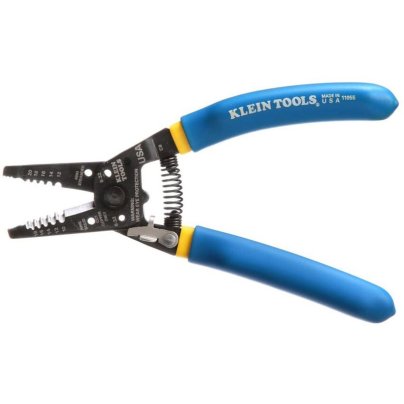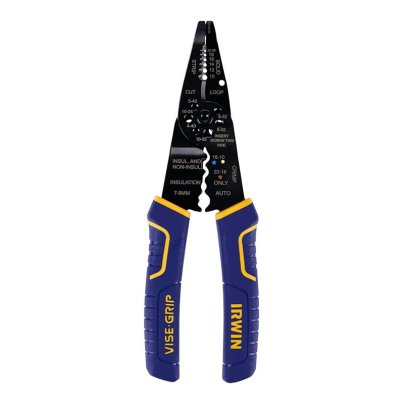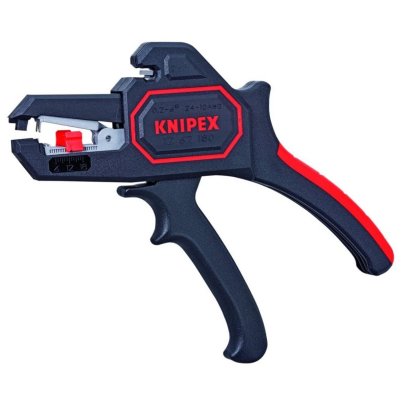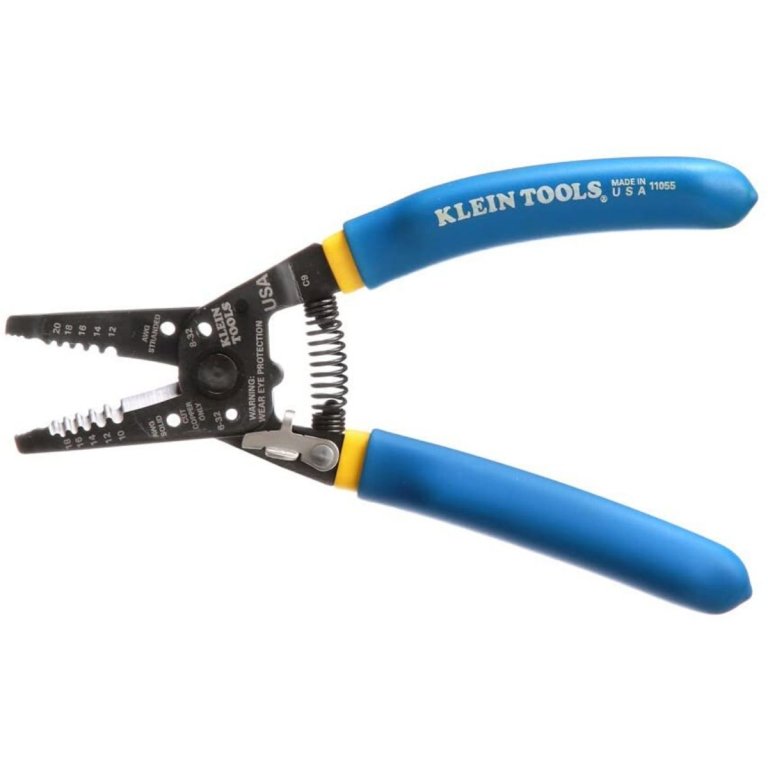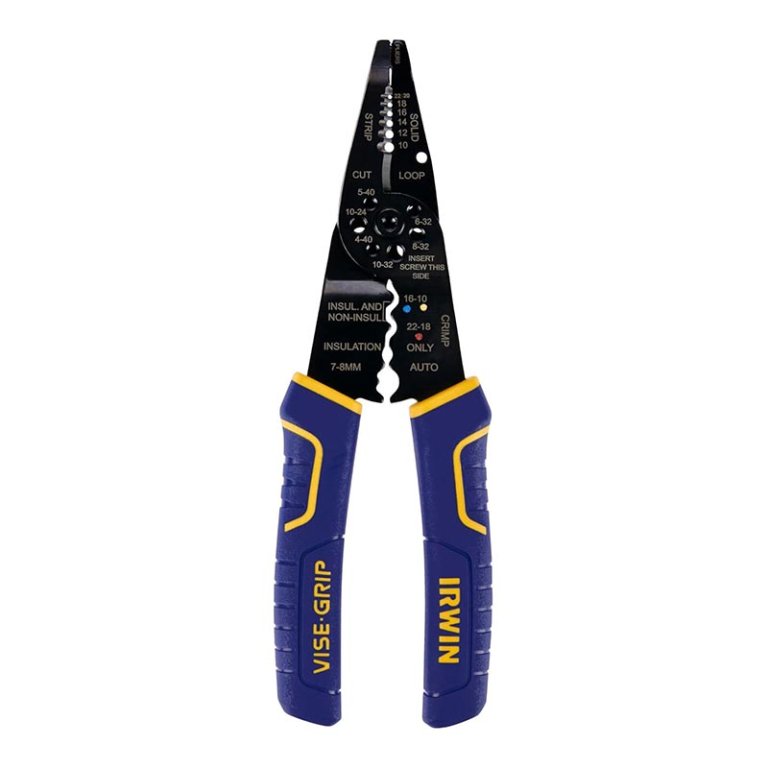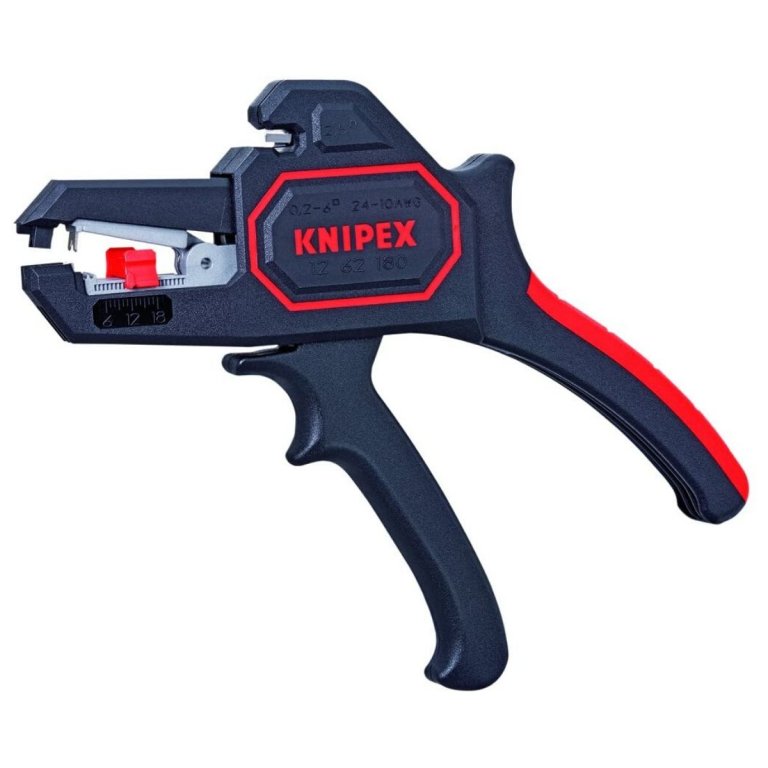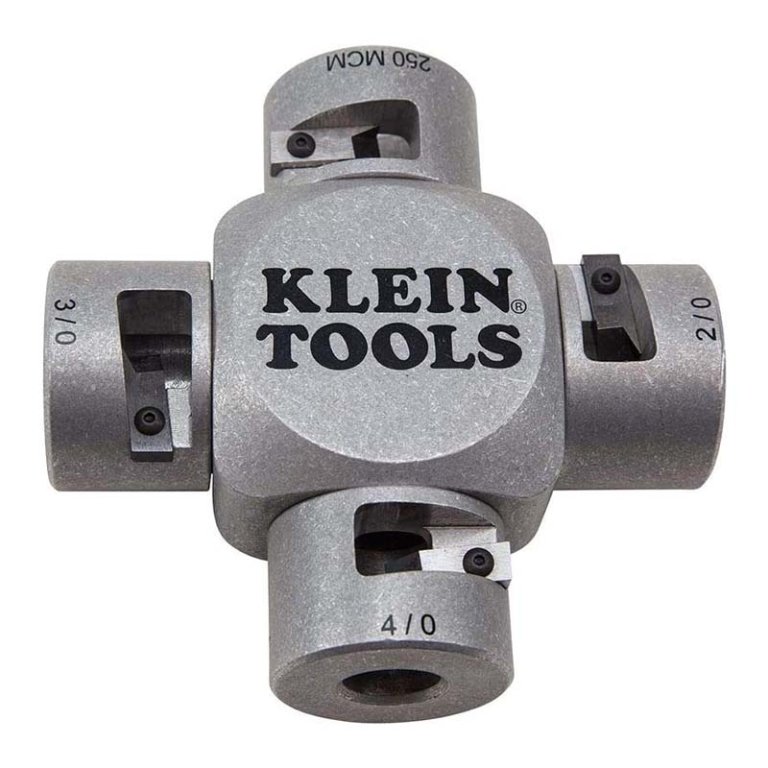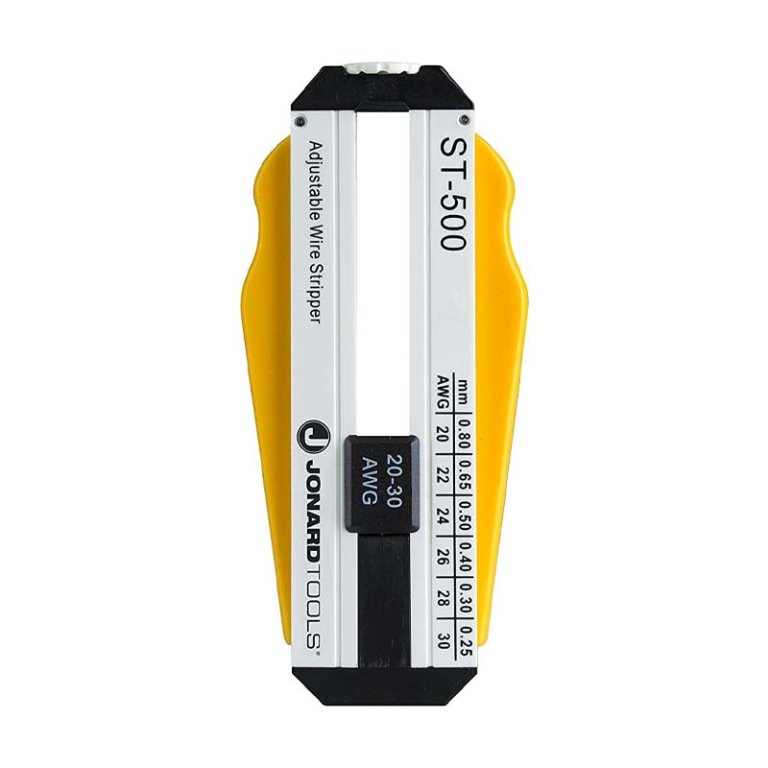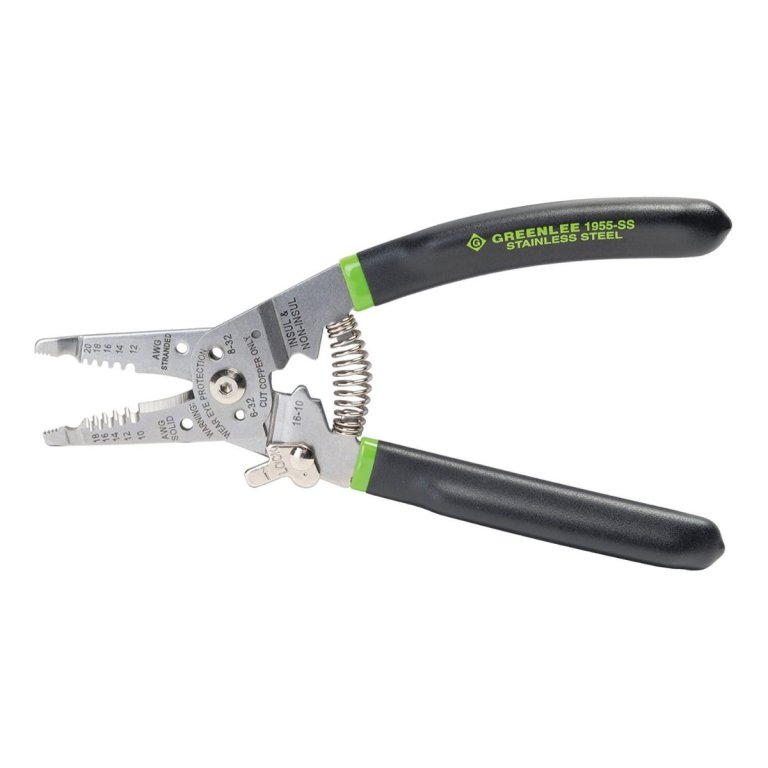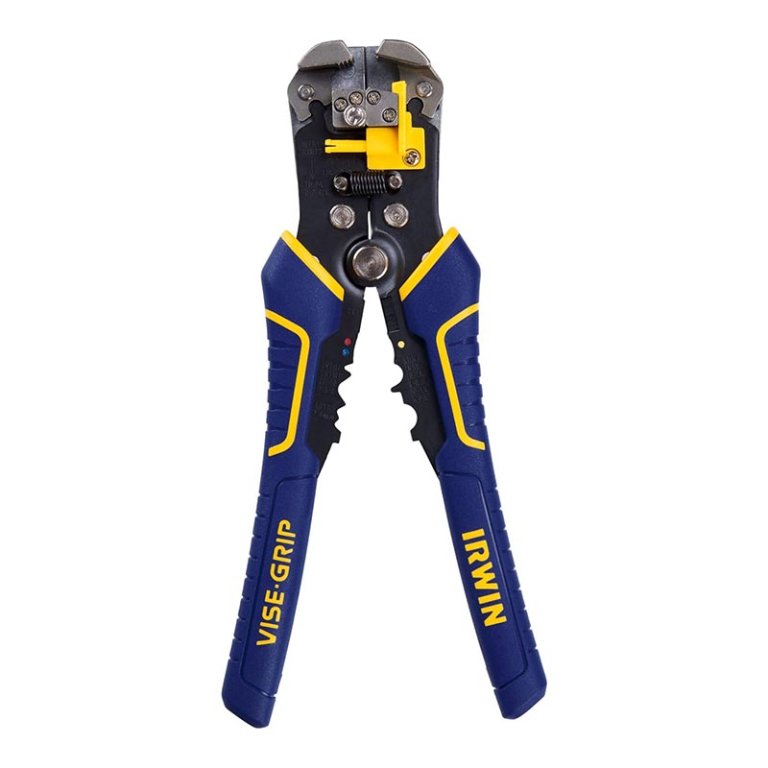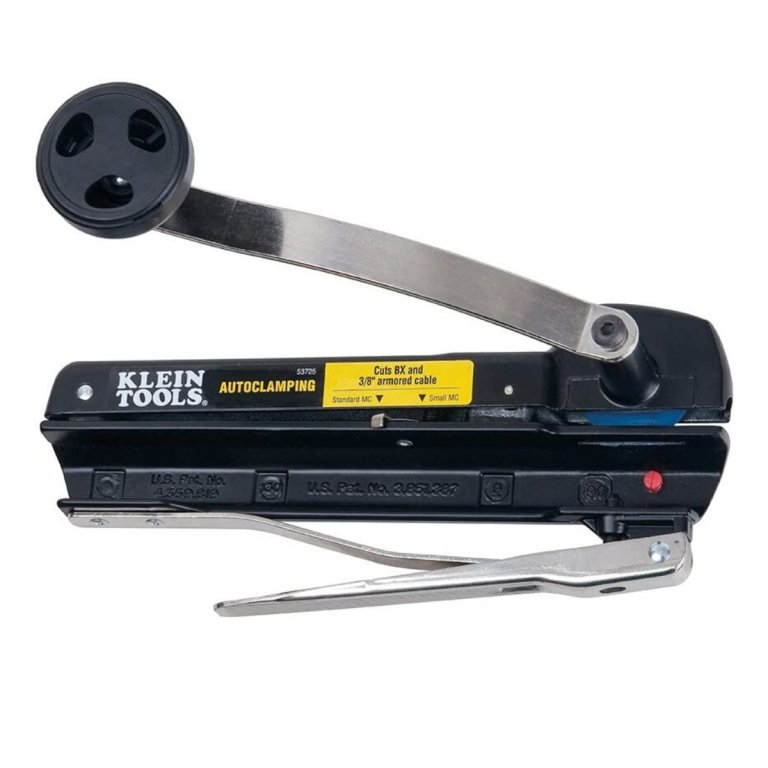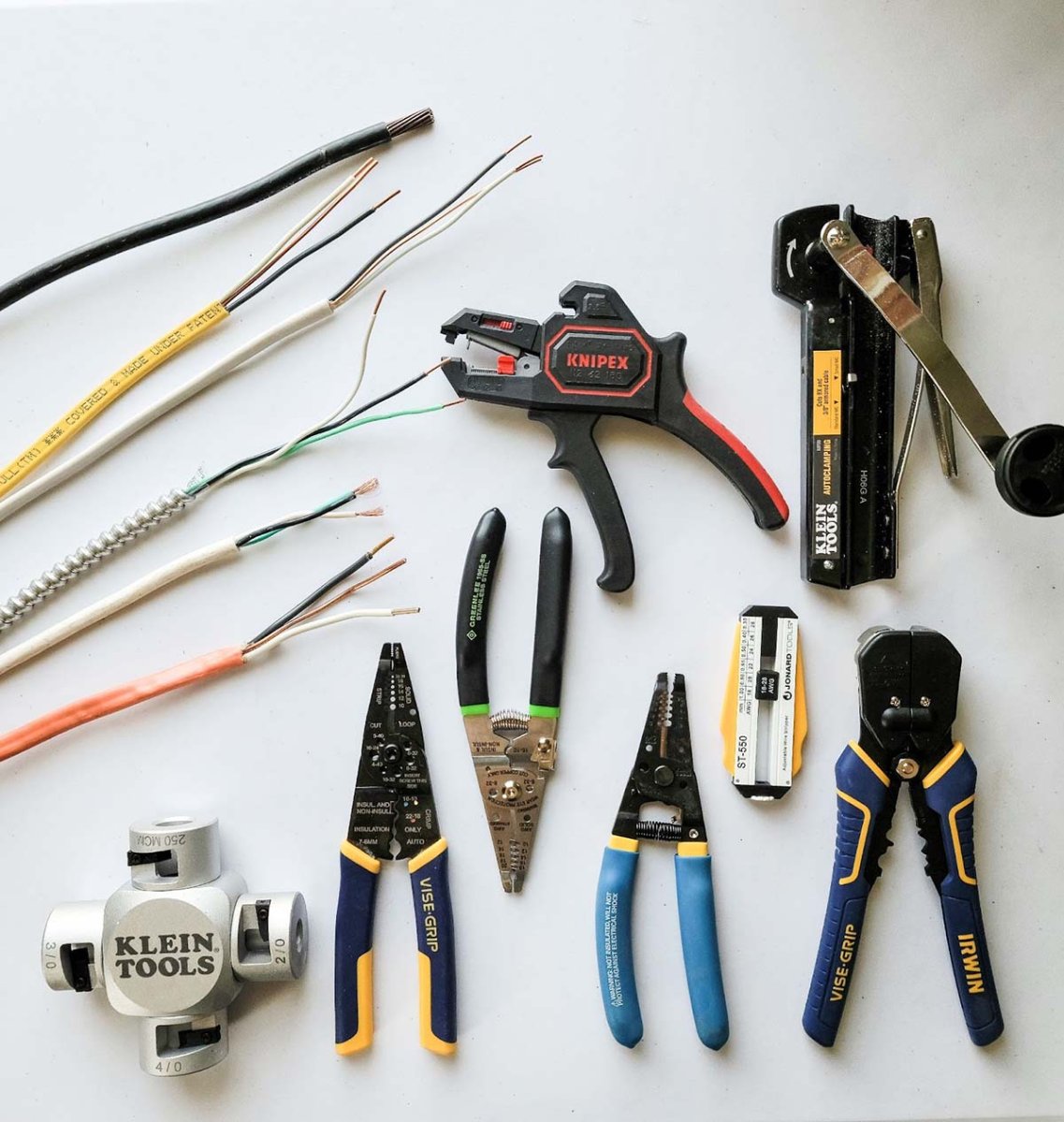
We may earn revenue from the products available on this page and participate in affiliate programs. Learn More ›
A wire stripper boosts productivity for professional electricians, budding apprentices, and DIYers, but with a variety of models on the market, the best tool depends on the wire the user is working with. We wanted to know how today’s top wire strippers perform in real-life projects, so we tested them. We cut and stripped a wide range of wire types and sizes, awarding points based on how well each tool functioned. Our Best Overall pick was the Klein Tools Solid and Stranded Wire Stripper; its spring-loaded action and cushioned, ergonomic grip made it super comfortable to use, plus its precision ground-cutting holes made consistently clean cuts.
Wire strippers can be more versatile than folks might think. Their primary purpose is to cut and remove the rubber coating that encases wire (known as the jacket), but some of the best models slice thick cables, cut screws to size, and crimp terminals onto the end of cables or wires.
Whether the user needs a basic or professional-grade wire stripper, there is an array from which to choose. Ahead, learn what to consider when shopping for the best wire stripper and find out how the following tools earned a spot in this lineup based on our hands-on tests.
- BEST OVERALL: Klein Tools Solid and Stranded Wire Stripper
↓ Jump to Review - BEST BANG FOR THE BUCK: Irwin Vise-Grip Multi-Tool Stripper/Crimper/Cutter
↓ Jump to Review - UPGRADE PICK: Knipex Tools 7¼-Inch Automatic Wire Stripper
↓ Jump to Review - BEST FOR PROS: Klein Tools Large Cable Stripper
↓ Jump to Review - BEST FOR ELECTRONICS: Jonard Tools Adjustable Wire Strippers
↓ Jump to Review - BEST SPRING-LOADED: Greenlee Hand Tools Wire Stripper/Cutter/Crimper
↓ Jump to Review - BEST SELF-ADJUSTING: Irwin Vise-Grip Self-Adjusting Wire Stripper
↓ Jump to Review - BEST FOR BX CABLE: Klein Tools Armored and BX Cable Cutter
↓ Jump to Review

Our Top Picks
Now that readers know what to look for when choosing the best pair of wire strippers for their projects, they can start shopping through some of the top products in the industry. The following lineup of wire strippers excelled in our hands-on tests. Check out the pros and cons of each tool before making a selection to ensure the best fit for your wiring needs.
Best Overall
Klein Tools Solid and Stranded Wire Stripper
See ItWhat We Like
- Cuts 6-32 and 8-32 screws to size
- Spring-loaded handles
- Cushioned, ergonomic grip
- Precision-ground cutting holes
What We Don’t Like
- Does not include crimpers
- Thumb release is slightly stiff
Product Specs
- Model number: 11055
- AWG range: 10 to 20 gauge
- Crimping: No
Those seeking a basic set of wire strippers that come with labeled wire gauge sizes and are comfortable to use need look no further than Klein Tools Solid and Stranded Wire Stripper. We appreciated the spring-loaded action and the cushioned, ergonomic grip, which made this wire stripper comfortable enough for extended use. It features precision ground-cutting holes, which make consistently clean cuts every time a piece of wire is stripped. At just 9 inches long and weighing less than 6 ounces, it’s small enough to carry in a pocket or tool pouch, so it didn’t weigh us down.
The sharpened stripper notches accommodate wires from 10 to 20 gauge in size. We were able to cut through wire cleanly, using the marked holes in the base of the shear blades. The serrated steel of the tool’s needle-nose plier tips allowed us to grab and bend the ends of the wires for attaching them to electrical outlet terminal screws. The only real shortcoming of this tool is that it doesn’t include crimpers, which are often needed for automotive and computer work.
What our tester says: “I found the double-insulated covering on the handles, which adds shock safety when working with electrical wires, to be a definite plus.”—Glenda Taylor, Product Reviews tester & writer
Get the Klein Tools 11055 wire strippers at Amazon, Ace Hardware (2-piece set), or The Home Depot.
Best Bang for the Buck
Irwin Vise-Grip Multi-Tool Stripper/Crimper/Cutter
See ItWhat We Like
- Affordable
- Combination wire stripper, cutter, and crimper
- Hardened cutting teeth
What We Don’t Like
- Rigid plastic handle coating not very comfortable
- Not spring-loaded
Product Specs
- Model number: 2078309
- AWG range: 10 to 22 gauge
- Crimping: Yes
The modestly priced Irwin Vise-Grip Multi-Tool Stripper includes handy features such as hardened cutting teeth and electrical screw shears. We were impressed by the number of functions on the Irwin wire stripper, especially because it comes at a very attractive price point. In addition to cutting and stripping wires from 10 to 22 gauge in size, this handy tool offers crimping ability, so we could securely attach terminal connectors to the ends of the wires we’d stripped. In addition, the Irwin wire stripper boasts serrated plier tips that we used to bend the wires’ ends to attach them to nut-type terminals.
We detected two minor downsides, however. The rigid plastic used to insulate the handles didn’t feel too comfortable; we got the sense that we’d have sore hands using the tool for an extended period. Also, the strippers lack a spring to push them open—we needed to open the device manually each time we wanted to cut, crimp, or strip a new wire.
Get the Irwin Vise-Grip wire strippers on Amazon or Deasig.
Upgrade Pick
Knipex Tools 7¼-Inch Automatic Wire Stripper
See ItWhat We Like
- Automatically adjusts to the wire
- Oil-hardened interchangeable steel blades
- Fiberglass-reinforced body
- Good for short wires
What We Don’t Like
- No crimping ability
Product Specs
- Model number: 1262180
- AWG range: 10 to 24 gauge
- Crimping: No
The Knipex Tools Automatic Wire Stripper is ideal for use on computers, electrical box retrofits, and other jobs in tight spaces. This is an automatic stripper, so we were able to use it to strip the insulation from relatively short wires that we couldn’t really grasp. By positioning the end of a wire directly in the front teeth of the Knipex, all it took was a gentle squeeze on the trigger handle for the tool to firmly grasp the wire, cut the insulation, and then pull the insulated jacket off the end of the wire.
We successfully stripped wires ranging from 10 to 24 gauge without having to adjust the tool. The Knipex is self-adjusting, meaning it automatically uses the proper pressure to slice and strip the insulation no matter the wire gauge. We would like to have seen a crimping feature, but this tool is so quick and versatile, it’s a winner even without the ability to crimp.
Get the Knipex Tools wire strippers on Amazon or Knipex.
Best for Pros
Klein Tools Large Cable Stripper
See ItWhat We Don’t Like
- Does not crimp wire
- A bit cumbersome
Product Specs
- Model number: 21051
- AWG range: 250 to 2/0 MCM
- Crimping: No
Not all wires are small in diameter—larger-diameter cables, such as 2/0 gauge, are often necessary when running high-voltage or underground wires. In our experience, large-diameter wires and cables can be challenging to strip manually, which is usually done by scoring the cable jacket with a sharp knife around its perimeter and then pulling the jacket off. This takes up time better spent running and connecting the cables.
Though we were slightly skeptical about the Klein Tools Large Cable Stripper when we first inspected it, we’re happy to report that although it’s a simple tool, it’s highly effective for stripping four sizes of cable: 2/0, 3/0, 4/0, and 250 MCM. We found that after inserting the wire into the corresponding-size hole on the Klien stripper, all we had to do was twist the wire to strip the insulating jacket away. This tool works using the same concept as an old-fashioned pencil sharpener that fits into a student’s pencil box. Just insert the end of a cable, twist it, and the blades in the Klein stripper will slice the outer jacket cleanly away.
On the downside, this model doesn’t cut the wire and doesn’t have crimping ability. Still, it effectively strips away the insulation on large cables that would otherwise need to be cut and stripped manually.
Get the Klein Tools 21051 wire strippers at Amazon, The Home Depot or Klein Tools.
Best for Electronics
Jonard Tools Adjustable Wire Strippers
See ItWhat We Like
- Compact, easy to store
- Strips fine wires
- Simple to use
What We Don’t Like
- Does not crimp wire
- Made entirely from plastic
Product Specs
- Model number: ST-550
- AWG range: 18 to 22 gauge
- Crimping: No
Manually cutting the insulating jacket of a tiny wire with a sharp knife or razor and then stripping it off with your fingers can result in cutting through the entire wire rather than just the jacket, so we were excited to test the Jonard Tools small wire stripper. It handles narrow wires between 18 and 22 gauge, and we found it very easy to use.
At first glance, however, the Jonard wire stripper is underwhelming. It’s entirely made from plastic—even the stripping blades are plastic. Still, we found the Jonard tool quite handy for stripping fine wires.
The tool works through a simple premise: By turning a small wheel at one end, the blades adjust to accommodate different size wires. After that, all that’s required is squeezing the top and bottom sides of the tool to create enough pressure to cut through the wire’s insulated jacket. It works, but only for fine wires; anything larger than 18 gauge won’t fit, and the plastic construction probably wouldn’t stand up to heavier-gauge wires.
A small black slider allowed us to adjust the length of the stripped section of the wire easily. Unfortunately, the provided increments are not labeled—we just had to know the difference between ¼- and ⅛-inch increments. We wished the cutting blades and the turning wheel were made of metal to last longer, but the Jonard does perform the function it was designed for—stripping fine wires—and as such, it’s a boon for those who work with electronics.
Get the Jonard Tools wire strippers at Amazon, Lowe’s, or The Home Depot.
Best Spring-Loaded
Greenlee Hand Tools Wire Stripper/Cutter/Crimper
See ItWhat We Like
- Stripper and crimper in one tool
- Spring-loaded handles
- Shears 6-32 and 8-32 screws
- Comfortable grip
What We Don’t Like
- Thumb-lock sticks
Product Specs
- Model number: 1955-SS
- AWG range: 10 to 20 gauge
- Crimping: Yes
Typical pliers without spring-loaded handles require a perfectly orchestrated finger grip for one-handed opening and closing. Most DIYers need time to develop that expertise. Greenlee’s wire stripper has spring-loaded handles to overcome this learning curve. We know pro electricians often choose nonspring-loaded wire cutters, but we prefer ones with springs.
This stripper works with 10- to 20-gauge wire, which is ideal for most home projects. Plus, we could shear off the tip of a small 6-32 copper screw without exerting a lot of pressure on the handles; the Greenlee will also shear 8-32 sized screws. The slide-on nonslip grips proved to be very comfortable. This is a top choice for those who want an all-in-one stripper tool.
What our tester says: “I was able to crimp connective terminals on the wire ends using the crimper function just below the fulcrum of the tool, and its needle-nose plier tips worked well for grabbing and pulling wires out from the back of an outlet.”
Get the Greenlee wire strippers at Amazon, Acme Tools, or Global Industrial.
Best Self-Adjusting
Irwin Vise-Grip Self-Adjusting Wire Stripper
See ItWhat We Like
- Self-adjusting mechanism
- Wire cutter and crimper in 1 tool
- ProTouch grip reduces hand fatigue
What We Don’t Like
- Requires strong grip
Product Specs
- Model number: 2078300
- AWG range: 10 to 24 gauge
- Crimping: Yes
Professionals and DIYers can easily use the Irwin Vise-Grip, even with just one hand. Simply slide the wire through the jaws, squeeze the handle, and produce a perfectly stripped wire. Plus, this model cuts wire.
This wire stripper works differently from any of the other tools we tested. We inserted the wire horizontally just below the two uppermost metal clamps and then squeezed the handles together. As we squeezed, the left clamp lowered to trap the wire, and then the right clamp cut the insulating jacket and pulled it off—all this with a single squeeze.
We tested the stripper on a range of wire sizes; each time, only the insulating jacket was cut and not the wire beneath. We didn’t have to make any adjustments to the tool—it adjusted itself to the wire size, which was pretty impressive.
The tool works on wires between 10 and 24 gauge. These strippers also feature built-in crimpers, which are color-coded to match the most common types of wire connectors.
What our tester says: “Those in the market for just one wiring tool that does it all will definitely want to consider this self-adjusting Irwin model.”
Get the Irwin Vise-Grip self-adjusting wire strippers on Amazon or at Lowe’s.
Best for BX Cable
Klein Tools Armored and BX Cable Cutter
See ItWhat We Like
- Won’t nick cable
- Cuts cables with up to 4 wires
- Swift-cutting blade eliminates burrs
What We Don’t Like
- Assembly required
Product Specs
- Model number: 53725
- Cuts: ⅜-inch cable
- Crimping: No
DIYers who work with metal-clad, BX, and armored cables will find that the Armored and BX Cable Cutter from Klein Tools quickly and accurately strips armor. This model accepts ⅜-inch metal-clad cable and uses a hand crank and rotary wheel to slice the armored jacket fast.
In the past, we’ve cut armored cable using a hacksaw, which incurs a risk of cutting a bit too far and nicking the wires within. We’ve heard others complain of this as well—we’re not the only ones! Fortunately, we’re happy to report that the Armored Cable Cutter is a game changer when it comes to making clean cuts.
The tool comes disassembled, however, and the directions aren’t very explanatory, so it took about 10 minutes to put it together correctly. Tip: The little circular blade that cuts through the wire’s steel-reinforced jacket is tucked away in the cylinder-shaped handle knob.
Once assembled, the cable stripper is straightforward to use. We placed the cable in the slot provided, compressed the handle to grip it firmly, and then turned the wheel to cut the cable’s steel jacket. After that, a simple twist of the jacket was all it took to loosen and pull it off. This is a tool most DIYers won’t use daily, but when cutting armored cable is necessary, it makes the task simple, clean, and quick.
Get the Klein Tools BX wire strippers at Amazon, Ace Hardware, or The Home Depot.
Jump to Our Top Picks
How We Tested the Best Wire Strippers
To select the wire strippers we wanted to test, we researched the models offered by the top tool brands with high customer satisfaction. We considered build material, AWG range, functionality, comfort, ease of use, and unique features.
We made sure to select tools with AWG ranges of 10 to 18 gauge or 10 to 24 gauge to accommodate a variety of wire sizes. Plus, we added a couple of cable strippers to the mix.
We tested each of the wire strippers to see how effectively they severed the wire’s insulated jacket. We automatically eliminated any wire strippers that cut or nicked the wires within the jacket—a fatal flaw by our standards.
We tested each of the functions on every tool, which included the ability to cut wires, shear screws, and crimp electrical connectors to the ends of wires. We awarded points based on a rubric for how well each function worked during testing. We also graded the tools based on how comfortable they were to use, whether they required assembly, and whether they offered automatic, self-adjusting features.
After the testing, we tallied the points and used them to choose the best product for each category.
What to Consider When Choosing the Best Wire Strippers
Now that readers are armed with knowledge about the types of wire strippers, it’s time to read up on other important factors and features to consider when shopping for a set. Here’s what to keep in mind when evaluating the best wire strippers for electrical projects.
Material
The materials of the jaws, handles, and any mechanisms can determine the quality and longevity buyers can expect from a pair of wire strippers. Most wires are copper, which is a soft metal that most other metals can easily cut through. However, when using a wire stripper to cut screws to length or punch through knockouts, a sturdy material is necessary.
Steel is a fine material for wire strippers, as it’s durable and affordable. Just make sure the strippers have hardened cutting teeth for the sake of longevity. Also note that not all grip coatings are equal in quality. A high-quality rubber or silicone grip will be comfortable to grab but durable enough to withstand heavy-duty projects.
AWG Range
Luckily, users needn’t carry a separate pair of wire strippers for each wire gauge identified by the wire-standardizing system known as American Wire Gauge (AWG). One set of wire strippers can cover a large range of wire sizes.
However, wire strippers that can handle burly 2- and 4-gauge wires won’t work for thin 22-gauge wires. Unless users are professional electricians, computer technicians, or tech hobbyists, they may never deal with wires on either end of this spectrum, so a good do-it-all set of strippers that works with wires typically encountered during a home repair or installation should suffice. In general, this would be between 10 and 18 gauge.
Computer techs and electronics hobbyists may need a stripper that works with thinner gauge numbers, preferring a gauge range of between 20 and 30. These strippers will work with the fine wires found in a drone, a train set, electronics control boards, and other smaller projects.
Precision and Accuracy
Gauged wire strippers must be precise and accurate to avoid frustrating mistakes. The teeth on low-quality strippers can be off by quite a bit or break down quickly. These inaccuracies can cause a user who is wiring a light fixture, for example, to cut the wire unintentionally while stripping, then breaking it off while twisting it.
Another issue with low-quality strippers can be struggling just to get through the jacket, forcing users to choose a smaller set of teeth that will accidentally cut into the wire. For example, if trying to strip a 10-gauge wire, the 10-gauge teeth notch on a cheap wire stripper may merely scratch the jacket, not cut it sufficiently to remove it. The user may then opt for a smaller gauge notch, such as a 12-gauge notch, that could inadvertently cut too deeply and damage the wire inside the jacket.
Although there are no tests or certifications for precision and accuracy, purchasing a tool from a recognized manufacturer that sells quality tools will help ensure that strippers will do their job accurately. A stripper that’s used properly can last a lifetime, and a drop of oil every now and then can help maintain smooth opening and closing.
Features
For such a simple tool, a lot of helpful features can be packed into a set of wire strippers. Electricians often need to work atop ladders, which limits access to tools on the ground, so the more a pair of strippers can do, the better.
Shoppers will find features such as threaded bolt cutters, crimps for cable ends, and serrated jaws for gripping wires. There are also wire strippers with needle-nose jaws that can reach into a tight spot such as a junction box. Also, spring-loaded handles can be a big help for those still developing their technique, as they’ll allow users to use the wire strippers with one hand while holding the wire with the other.
Comfort
When wiring only one or two outlets, comfort might not be much of an issue when choosing a wire stripper. However, those with a full day of wiring ahead will want a comfortable set of strippers with nicely coated handles.
Most wire strippers have rubber coating over their handles to provide a comfortable, nonslip surface for all-day use without causing pain or discomfort. The higher the quality of the tool, however, the better the rubber used for these handles. In many cases, manufacturers use silicone, as it’s soft to the touch and less likely to slip off the end of the handles.
There also are double-layered grips that add even more cushioning. These strippers have an inner rubber layer around the handle for grip on the tool and a softer outer layer for comfort.
Safety
When working with tools, safety is always a consideration, and wire strippers for your electrical project are no different. The following features add safety:
- A nonslip handle can be crucial, as losing grip on your tool could potentially cause a cut or injury, particularly when removing the wire’s jacket.
- Spring-loaded handles will help prevent cramping or other discomfort that might occur with prolonged use.
- An AWG range that fits with the wires users work with most often will help them avoid using the wrong tool for the job, which always has the potential to go badly.
Ease of Use
When it comes to ease of use, there’s no beating a set of automatic, self-adjusting wire strippers. These models automatically detect the thickness or gauge of a wire, easily cutting through the jacket and also removing it via a mechanism that grips the jacket and pulls it off the wire.
As mentioned earlier, spring-loaded handles make opening and closing a pair of strippers easier with one hand. Though a user can develop the technique to open any pair with one hand, spring-loaded handles are quicker and easier to handle, particularly when working on a ladder or in a tight space.
With gauged wire strippers, clearly legible printing on the teeth will help users line up the wire quickly and accurately. Having to guess tends to lead to mistakes, sometimes requiring starting over.
Types of Wire Strippers
To compare effectively the best wire strippers for electrical projects, it’s helpful to learn a bit about the styles of strippers available. One kind might be a better fit for a user’s workflow or project than others. Check out the five main types of wire strippers below.
Adjustable
Those looking for a basic one-size-fits-all-style tool should consider an adjustable wire stripper. These strippers have plier-style handles that slide to adjust the opening of the jaws. After adjusting to the right size, a quick squeeze will cut the wire’s jacket. Then slide the stripper to remove the jacket and expose the copper wire. New users may find this style of stripper a bit more finicky than others, but in time, most folks develop a feel for them to avoid cutting into the wire.
Gauged
Gauged wire strippers are all about choices. These tools have a range of individual teeth meant for specific wire sizes. As long as attention is paid to the wire size and the teeth being used, these tools will cut the jacket without any chance of slicing into the actual wire. For instance, placing an 18-gauge wire in the 18-gauge section will slice the jacket nicely, allowing for easy removal. Gauged wire strippers are great for beginners, as they’re inexpensive and easy to use.
Self-Adjusting or Automatic
Those who prefer the fastest approach to wire stripping may prefer a self-adjusting (or automatic) stripper. These tools come in pistol-grip or plier-handled styles. As the handles are squeezed together, the spring-loaded teeth in the head sense the wire’s size and slice into the jacket. These strippers also automatically remove the jacket, so users needn’t pull it off of the end of the wire. Though easy to use, this type of stripper is expensive and can be bulky in a tool pouch.
Gauged Automatic
Gauged automatic strippers are a combination of the features in a gauged stripper and the automatic jacket removal of a self-adjusting stripper. After placing the wire in the correct gauge, squeezing the handle cuts through the casing and separates the jacket from the wire at the same time. They’re expensive and bulky, but compared to a set of gauged strippers, a gauged automatic stripper can save time.
Wire Stripper and Cutter
Many old-school electricians never use wire strippers. Instead, they’ll use a trusty pair of linesman pliers to strip wires. These beefy pliers have cutting edges that electricians can use to cut the wire to length. They can then score the outside of the jacket at the proper location by applying light pressure to the handle. These pliers are very sturdy, so electricians often also use them to punch through knockouts on electrical boxes and secure screw-down wire entries.
FAQs
The following is a collection of some of the most frequently asked questions about wire strippers. If consumers still have queries after reading through it, they may want to contact a wire stripper’s manufacturer and speak with a customer service representative.
Using an automatic, self-adjusting wire stripper, such as our upgrade pick, the Knipex Tools wire strippers, is by far the best way to strip wires quickly.
The easiest way to strip copper from a wire jacket is to use a utility knife and slice the jacket down the length of the wire. Be sure to place the wire on a tabletop and keep your free hand safely behind the knife.
Some strippers certainly can crimp terminal connectors onto wire. Some linesman-style pliers and wire strippers have built-in crimping grooves that create strong and secure connections on cable ends.
Scrap yards have two prices: dirty and clean. Dirty copper wire includes wire with its jacket, nuts, outlets, or anything the scrapper must remove before recycling the copper. Clean prices are higher, so it can be worth your time to strip the copper out of the jacket before turning it in.
Meet the Tester
Glenda Taylor is a product tester and writer specializing in the construction, remodeling, and real estate industries. She and her husband own a general contracting company, and Taylor is experienced in both residential and commercial building applications. She tests a wide range of power tools as well as other home improvement, household, and lawn-and-garden products.
